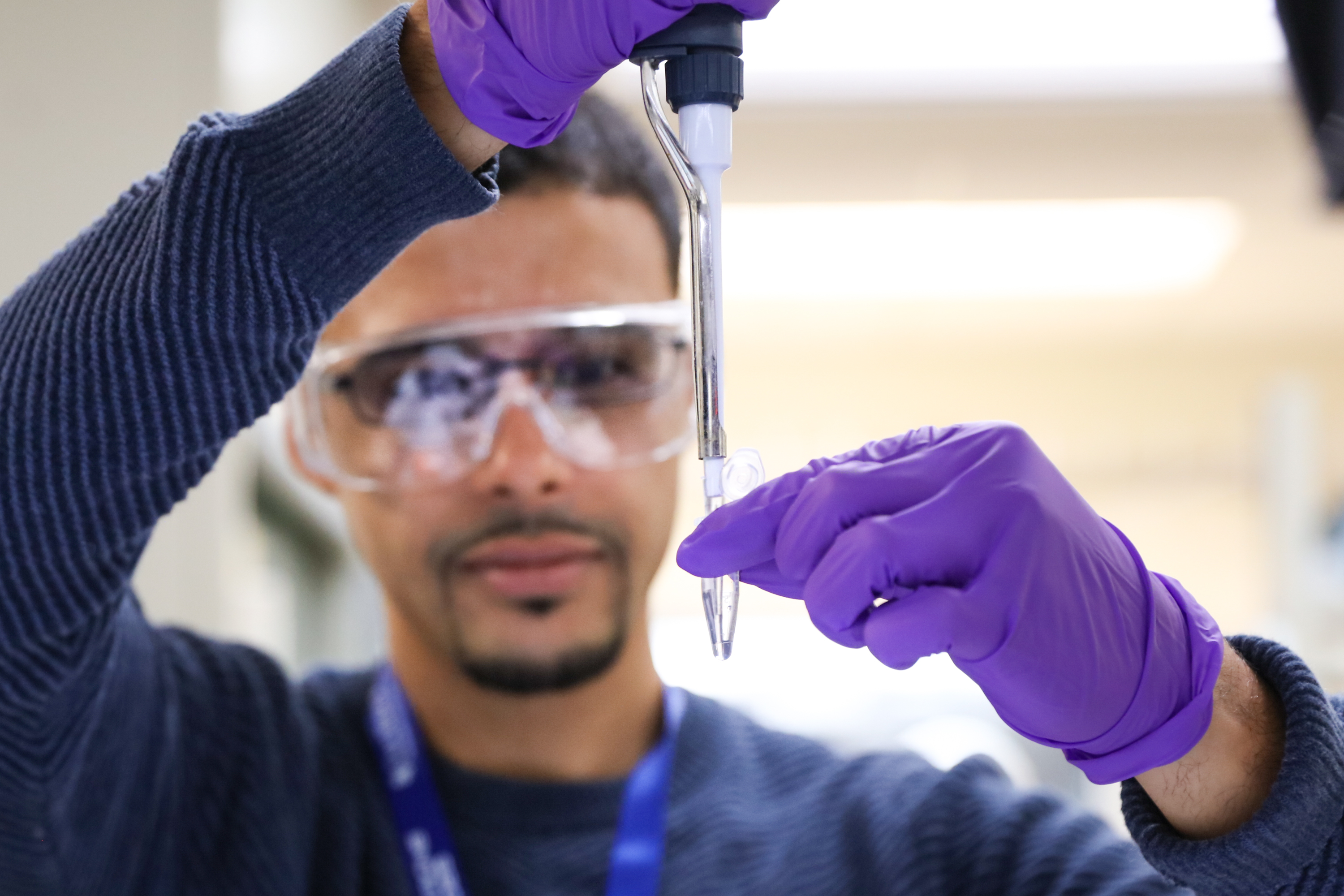To investigate what happens inside cells when they are at risk of becoming cancerous, scientists working in Richard Kriwacki’s laboratory at St. Jude Children’s Research Hospital have been using neutrons at the Department of Energy’s (DOE’s) Oak Ridge National Laboratory (ORNL). The team is searching to better understand the altered state of the nucleolus—a membrane-less organelle inside the cell—when the cell is compromised. Novel insights into cell behavior at the atomic and molecular scales will enable better detection and treatment of cancer in its many forms.
“For over 100 years, it’s been known that cancer cells have larger nucleoli than normal cells. Nucleoli are like fluid factories, or assembly lines for the production of ribosomes—complex enzymes that link amino acids together to make proteins. The level of ribosome production is related to how quickly the cell can grow,” said Eric Gibbs, a postdoctoral researcher working in Kriwacki’s group. “Preventing uncontrolled ribosome biogenesis is critical to preventing the propagation, or the spread, of cancer cells throughout the body.”
In early 2020, before the COVID-19 pandemic began, Gibbs performed neutron scattering experiments at ORNL’s Spallation Neutron Source (SNS) to study the interactions between two nucleolar proteins—nucleophosmin and a naturally occurring tumor suppressor protein called the alternative reading frame, or ARF. The ARF tumor suppressor is expressed when cells sense the early changes on the path to becoming cancerous—a process termed oncogenic stress.
According to Gibbs, nucleophosmin aids in the assembly of ribosomal components in the nucleolus that include multiple protein and RNA molecules. Nucleophosmin also acts as an escort for assembled pre-ribosomal particles during their transport from the nucleus—the membrane-bound organelle that encases the nucleolus—to the cytoplasm outside the nucleus where all cellular proteins are synthesized.
“When cells experience oncogenic stress, the ARF tumor suppressor is overexpressed, or upregulated, and shuts down the ribosomal assembly line by causing the pre-ribosomal particles to get stuck in the nucleolus, thus halting protein production,” he said.
The ARF tumor suppressor is important, Gibbs said, because it’s among the top three genes that are mutated in almost all cancers.
Previous studies by St. Jude and other researchers found that when the ARF gene was deleted, the size of a cell’s nucleolus increased, as did the rate of ribosome assembly. They found that the cell would produce significantly more protein than healthy cells normally do, resulting in abnormal cancer cell growth and proliferation. Understanding the mechanism, or exactly how ARF works, could be paramount to a deeper understanding of tumor suppression, which could lead to novel insights into improved therapeutics for patients.
One hypothesis regarding the ARF mechanism involves a process called liquid–liquid phase separation—the same process by which oil and water separate when mixed together. Whereas the cell’s nucleus is filled with a liquid-like nucleoplasm fluid encased by a membrane, the nucleolus inside the nucleus has no such membrane barrier, consisting instead mainly of proteins and nucleic acids held together via phase separation.
When nucleophosmin and other proteins or RNA are isolated and mixed together in solution, phase-separated droplets are formed. The consistency of the droplets is similar to the physiological environment of the nucleolus and provides a model system to study the interactions between nucleophosmin and different proteins or RNAs.
In most cases, the droplets are highly fluid and liquid-like, enabling them to fuse together into larger droplets. But when nucleophosmin is mixed with ARF, the consistency is far more gelatinous, more rigid, which significantly restricts droplet fusion.
“So, why is that? Is it something about the organization of the nucleophosmin molecules? Do different concentrations of ARF cause the nucleophosmin molecules to be more or less mobile? Are the nucleophosmin molecules farther apart or closer together? These are things we’re really keen on investigating,” said Gibbs. “We think it’s related to the effects of ARF on phase separation by nucleophosmin—possibly when ARF is overexpressed, the nucleolus becomes a more rigid structure because the nucleophosmin molecules are more closely spaced.”
Neutrons are ideal probes for studying biological matter because of their neutral charge, their nondestructive effects on samples, and their sensitivity to light elements such as hydrogen. They can be used to measure the size, shape, and organization of molecules in a wide range of environments and conditions that are inaccessible with other techniques.
Using the EQ-SANS instrument at ORNL’s SNS, Gibbs was able to analyze the molecular structures of many different samples with varying concentrations of ARF and nucleophosmin. The experiments helped determine how ARF affects the structural organization of nucleophosmin molecules within phase-separated droplets in the test tube and provide new insights into how ARF stops ribosome biogenesis in the nucleolus as it suppresses tumors.
“One of the cool things about neutrons is that we’re able to use contrast variation that allows us to switch between looking at just the ARF molecules, or just the nucleophosmin molecules, within droplets, in addition to being able to look at both at the same time.
“We’ve identified some interesting features in the ARF tumor suppressor already. For example, it has certain hydrophobic motifs, which repel water, as well as positively charged, hydrophilic motifs, that attract water—both of which influence how ARF binds to nucleophosmin and forms droplets through phase separation,” said Gibbs. “The more we can learn about these interactions, the better equipped we’ll be in fighting cancer.”
Kriwacki added, “These observations, for the first time, show that ARF, a key tumor suppressor protein in humans, needs to be viewed through the lens of phase separation to understand its inhibitory effects on nucleoli in pre-cancerous cells.”
Related publication: eLife, “Nucleophosmin integrates within the nucleolus via multi-modal interactions with proteins displaying R-rich linear motifs and rRNA.”
SNS is a DOE Office of Science User Facility. UT-Battelle LLC manages ORNL for the DOE Office of Science. The Office of Science is the single largest supporter of basic research in the physical sciences in the United States and is working to address some of the most pressing challenges of our time. For more information, please visit www.energy.gov/science.—by Jeremy Rumsey




